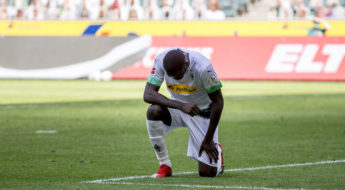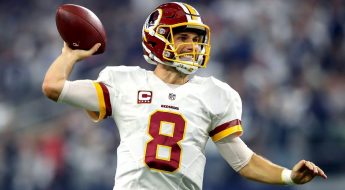Introducing the 'Bag' Hall of Fame: Eight NFL stars who got PAID, over and over and over again
It’s time to bestow a new honor on a handful of NFL legends. While many of these players do great work on the field, I’m happy to finally give them the credit they deserve for what they’ve done in fighting some of the most penurious people on the planet: NFL team owners. It’s time to induct the inaugural class of players into the Bag Hall of Fame (BHOF).
Now, I need to be very clear here. This isn’t an attempt to honor players who were overpaid or didn’t deserve the money they made during their time in the NFL. I’d reject that concept in principle: Just about every player, past or present, was or is underpaid relative to the risks they take by playing professional football. There’s no fun in poking at backup quarterbacks who were able to collect checks while rarely stepping on the field.
Subscribe: ‘The Bill Barnwell Show’
Instead, I want to reward the players who did the best job of maximizing their leverage and getting paid for their ability. Players who pushed holdouts to the next level. Players who bet on themselves and were handsomely rewarded for doing so. Players who even managed to represent themselves in negotiations and pocket millions of dollars that would have otherwise gone to an agent.
For this first class, the selection committee (me) is inducting eight players into what will surely one day be a physical Hall of Fame. Most of the players are still active, but they’ve already done enough to earn their way into the BHOF without a five-year waiting period. Many of them have won Super Bowls, and a handful are either in the Pro Football Hall of Fame or should end up in Canton someday. That Hall of Fame, though, won’t be the only institution honoring them for their work. Here’s our first class of players:
Jump to a Bag Hall of Famer:
Kirk Cousins | Joe Flacco
Dak Prescott | Jalen Ramsey
Darrelle Revis | Deion Sanders
Matthew Stafford | Laremy Tunsil
Editor’s Picks
2 Related
Cousins responded with a Pro Bowl campaign, throwing for 4,917 yards with 25 touchdowns while finishing sixth in QBR. Now, one year away from what would have been unrestricted free agency given the outlandish cost of a potential third franchise tag, the two sides seemed to entrench themselves even further. Washington tried to negotiate in public, suggesting that its best offer guaranteed Cousins $53 million. In sharing that information, executive Bruce Allen repeatedly referred to his team’s starting quarterback as “Kurt,” a slight that would have been inexplicable for every other organization but this one.
Cousins signed a second franchise tag for just under $24 million. After the year, Washington traded for Alex Smith, signaling the end of the Cousins era. It netted a third-round compensatory pick and turned that into running back Bryce Love and guard Wes Martin, who started a combined 10 NFL games. Thirteen different quarterbacks started at least one game for Washington between Cousins’ departure and the arrival of Jayden Daniels last season, a stretch in which it went 36-62-1.
Quarterbacks in their 20s with a track record of above-average play and no significant injury history almost never hit free agency, which gave Cousins the ability to dictate terms on the open market. With significant interest from multiple teams, he chose the Vikings over the Jets on what was a massive deal at the time — three years and $84 million, $82.5 million of which was fully guaranteed. Cousins also landed a no-trade clause and a no-transition tag clause, allowing him to hit free agency again unless the Vikings franchised or extended him.
The Vikings chose to extend Cousins in 2020, giving him another $31 million in guarantees for an additional season in 2021. The following year saw the new Kwesi Adofo-Mensah-led regime pay him $35 million for another year, using the new deal to reduce what had become an onerous cap hit for the signal-caller. Only after 2023, when Cousins tore his Achilles during one of the best seasons of his career, did the Vikings finally extricate themselves, replacing Cousins with Sam Darnold and first-round pick J.J. McCarthy.
Given one more shot at unrestricted free agency as a viable starter, Cousins quickly inked a four-year, $180 million deal with the Falcons. Atlanta’s aggressive decision seemed bizarre when it used its first-round pick on Michael Penix Jr. the following month, but Cousins was well-protected. His deal was essentially a one-year pact for $90 million, a two-year deal for $100 million or a three-year contract for $135 million.
With the Falcons promoting Penix to the starting job amid Cousins’ struggles last season, it seems likely they’ll choose the two-year option. I wouldn’t be surprised if Cousins landed some guaranteed money from another team in 2026 if he returns for another season, but even if he retires, he has become the best-compensated free agent in league history. Most of the highest-paid players ever — such as Aaron Rodgers, Matt Ryan and Russell Wilson — earned the majority of their money from extensions with the teams who drafted them or signed new deals after being traded elsewhere. Cousins, currently the sixth-highest-paid player in league history, will finish this Falcons deal having earned more than $285 million from teams that signed him as an unrestricted free agent.
While the salary cap will eventually grow to the point where that figure is topped, the only other player in the same stratosphere in terms of earning money as a free agent (and the extensions that followed) is Drew Brees, who made more than $256 million after signing with the Saints. The only other players who topped $100 million in earnings from teams that signed them as free agents are Ryan Tannehill ($123.4 million) and Ndamukong Suh ($104 million). Is Cousins going to be a Hall of Famer like Brees or Rodgers one day? No. Does he belong in the Bag Hall of Fame? There can be no doubt.
Prescott got everything he wanted and more. He received a four-year, $160 million deal with that $40 million average annual salary. By never signing the tag and limiting his new deal to four years, he got a chance to hit free agency again after his age-31 season, still firmly in the peak years for quarterbacks. And crucially, his new deal had no-tag and no-trade clauses, meaning he would potentially have even more leverage at the end of this contract.
Sure enough, after Prescott finished second in MVP balloting in 2023, the Cowboys had little choice but to give their long-term starter a record-setting deal. Prescott’s next four-year deal was for a whopping $240 million, with records for average annual salary ($60 million), most single-season cash ($86.3 million), cash over the first three years ($174.1 million) and the largest signing bonus ever ($80 million). Again, he was able to negotiate no-trade and no-tag clauses, giving him added leverage at the end of this pact.
It seems telling that other teams haven’t even been willing to match this Prescott deal for their own quarterbacks and, at least so far, have treated it like an outlier. Josh Allen’s 2025 extension with the Bills, while it consists entirely of new money and erases his old contract, averages $55 million per season, despite the fact that he has been a more productive and successful quarterback than his Cowboys counterpart. The 49ers’ Brock Purdy, who was similarly underpaid as a late-round pick, signed a deal with an average salary of $53 million. At the moment, Prescott’s deal stands alone as the richest in all of football.
Between 2021 and 2024, Prescott took home a staggering $212.3 million, nearly $47 million more than any other player. We can (and often do) debate whether he’s that caliber of player, but it’s only a small factor in how and why he has gotten paid. The Cowboys haven’t been willing to face a future without him, and after playing the franchise tag game with their quarterback at the end of his rookie deal, they’ve been operating from a position of desperation during their negotiations. After being an afterthought and the league’s biggest bargain for four years, Prescott has turned the tables on Jones and the Cowboys.
In a difficult cap bind because of the deals and their spending elsewhere, the Lions repeatedly restructured Stafford’s and Suh’s deals to create short-term cap space. After Stafford’s fourth season, he signed a relatively player-friendly extension (three years, Catch up on the NFL offseason
As a quarterback entering the prime of his career with a Super Bowl ring in his pocket, Flacco was suddenly in the driver’s seat. After their prior Super Bowl win in 2000, the Ravens had let starting quarterback Trent Dilfer leave, replacing him with Elvis Grbac. They cycled through future starters over most of the next decade before eventually landing on Flacco. Even with franchise icon Ed Reed simultaneously hitting free agency, the Ravens needed to prioritize Flacco. Flacco and his representation were able to extract what was, at the time, the richest deal in NFL history. The Ravens signed Flacco to a six-year, $120.6 million contract. Before the season, the ceiling for Flacco’s negotiations was two franchise tags, which would have paid him about $33 million for two years. Instead, after his Super Bowl success, they paid him $51 million over two seasons and practically guaranteed another $11 million. Even that undersells how great of a deal this was for Flacco. Because the Ravens were in rough cap shape, the structure of the contract kept the cap figures low before the accounting jumped from $14.6 million in Year 3 to $28.6 million in Year 4. As a result, Baltimore was always likely to be in a position in which it would need to hand him a second contract after three seasons. And indeed, before the 2016 season, Flacco signed a three-year, $66 million extension, guaranteeing him another $44 million. Between 2013 and 2018, Flacco ended up taking home $124 million in cash, the fourth-most money of any player over that time frame. (That’s the equivalent of about $240 million relative to the current salary cap.) Over that run, he made just one run back to the postseason, winning a total of two playoff games and going 42-41 during the regular season. His 53.6 QBR ranked 20th out of the 26 quarterbacks who threw at least 1,500 passes over that six-year stretch. Coach John Harbaugh nearly lost his job after the 2017 season and was on the hot seat in 2018 before Flacco went down with a hip injury and the Ravens were forced to turn to first-round pick Lamar Jackson. You know what happened next. Download the ESPN app and enable Adam Schefter’s news alerts to receive push notifications for the latest updates first. Opt in by tapping the alerts bell in the top right corner. For more information, click here. With the Bucs, Revis got the sort of deal we haven’t seen from a star player since. Wanting to reset the market with a standout salary at the time, he signed a six-year, $96 million deal with the Buccaneers. It was a massive salary at the time (and the equivalent of a $36.3 million annual salary for a cornerback today), but the deal contained no guaranteed money. While that gave him the ability to potentially renegotiate if he exceeded expectations, it also gave Tampa Bay complete flexibility to move on from him. After one year, it did, releasing Revis with five (unguaranteed) years remaining on his existing deal. It was a rare misstep from the legendary defensive back, but things worked out fine for him. He signed a one-year, $12 million deal with the Patriots, placing one of the best man-to-man cornerbacks of his generation on a Bill Belichick defense that relied heavily on man coverage. This was essentially a one-year franchise tag, given that the corner tag in 2014 was $11.8 million. Revis proceeded to win the Super Bowl and was named a first-team All-Pro. With the structure of the deal preventing the Patriots from franchise-tagging him, the four-time first-team All-Pro got one more chance to hit free agency before turning 30. He returned to the Jets, with a five-year deal making him the highest-paid cornerback in the league and guaranteeing him $39 million. The contract paid him $16 million per season over the first three seasons on paper. Instead, the Jets paid Revis $39 million for two years, as the organization decided to move on after an excellent return in 2015 gave way to a disappointing second season. He parted ways with his agents in May 2016 and signed with the Chiefs late in the 2017 season, but after an underwhelming performance in a playoff loss to the Titans, he was cut. He retired in July 2018. In all, between signing that first extension with the Jets in 2010 and finishing his career with the Chiefs in 2017, Revis took home more than $101 million — nearly $26 million more than any other cornerback in the league over that span. The only non-quarterback who made more money over that stretch is Ndamukong Suh, who might be part of the 2026 BHOF class next offseason. As good as Revis was as a player, he might have been an even better negotiator. That move didn’t work, but Ramsey’s next play did. Two weeks into the season, a conversation with an unnamed member of the organization that Ramsey characterized as “disrespectful” led the star corner to request a trade. He then played one more game with the Jaguars before he began to miss time with a nagging back injury. I don’t like suggesting that a player was faking an injury, as every NFL player deals with meaningful aches and pains throughout the season. In the annals of medicine, though, few doctors and scientists have explored what appears to be a salve for back injuries: going to Los Angeles. Ramsey missed three games with a back injury that wasn’t “debilitating” before the Jags gave into his request and traded him to the Rams for two first-round picks. He stepped right into the lineup and played eight consecutive games before missing a meaningless Week 17 game with a knee injury. Ramsey wasn’t shy about his happiness in Los Angeles; he called the day of the trade “probably one of the best days of my life.” The Rams were more motivated to keep their new addition around. Ramsey waited to negotiate his extension with the Rams until after his fourth season was completed. Just before the 2020 season began, he inked a five-year deal worth $100 million, making him the highest-paid cornerback in league history. The Jags turned the first-rounders they got for him into pass rusher K’Lavon Chaisson and running back Travis Etienne Jr. After playing out three years of the new deal and winning a Super Bowl in Los Angeles, Ramsey was eager to get another deal done. With just $12.5 million in guarantees remaining on his existing contract, he prayed for another trade and got his wish, with the Rams sending him to the Dolphins for a third-round pick and backup tight end Hunter Long. As part of the deal, the Dolphins guaranteed the rest of his $17 million salary in 2023 and $14.5 million in 2024, adding $19 million in guarantees to his existing deal. While Ramsey missed half of his debut season in Miami with a knee injury, the Dolphins’ defense soared after his return to the lineup. One year after adjusting his deal as part of the trade, the Dolphins locked him up on a larger contract: his three-year, $72.4 million extension made him the league’s highest-paid cornerback for a second time, topping the deal that Pat Surtain II had signed days earlier. The deal came with more than $50 million in practical guarantees for Ramsey, who was locked in to earn just over $25 million in 2025. Ramsey is going to get his money, but it won’t be in Miami. Just one year after giving him his second contract in two years, the Dolphins and their star cornerback decided that it would be best to part ways. They made this decision in mid-April, long after the Dolphins had paid him $4 million and the rest of the league had spent the vast majority of their budget in free agency. Even if they did, with Ramsey turning 31 in October, there weren’t many teams that saw a $21 million investment in a veteran cornerback as great value. As a result, the Dolphins dealt Ramsey to the Steelers earlier this week in a fascinating challenge trade for veteran safety Minkah Fitzpatrick. Given what happened in Jacksonville, the Dolphins probably didn’t want to face a regular-season scenario in which they were relying on Ramsey to be a part of the lineup with a trade request on the cards. And Ramsey, to his credit, reportedly landed a $1.5 million bonus to sweeten the deal. Ramsey has played his cards well. He has been able to repeatedly maneuver to different organizations and get significant guarantees in the process. He signed two deals to be the highest-paid cornerback in football. He has repeatedly left struggling teams for more competitive ones, which is even true about his move this offseason. And I don’t think any NFL player has ever made an executive more angry with a novelty car rental. He’s a great player and a spectacular negotiator. • Early mock drafts: Miller | Reid According to Sanders, the 49ers never offered him a deal to stay in San Francisco. He was instead forced to settle for their archrivals, who made him the highest-paid defender in league history. Again, he waited until after the season started to sign with the Cowboys. His seven-year, $35 million deal included a record $12.99 million signing bonus. For reference, the salary cap in 1995 was just $37.1 million; this is something like an elite cornerback signing a seven-year, $263.4 million deal with a $97 million signing bonus under the current cap. The move inspired reverberations around the league. Teams complained to the league that Sanders’ deal and its large bonus circumvented the salary cap. Jerry Rice went on a tirade about how Sanders hadn’t won the Super Bowl for the 49ers. Emmitt Smith’s agent tried to use the Sanders contract to prevent the Cowboys from using the franchise tag to keep their star back. And Sanders delivered the goods. While he was limited to nine games in his debut season with the Cowboys, he suited up in the postseason and helped bring the Cowboys a Super Bowl title, his second in two years. Four years later, Sanders signed another massive deal with the Cowboys; this time, a five-year pact for $51.4 million. This deal didn’t last quite as long, with the Cowboys cutting Sanders after one year to avoid triggering $23 million in guarantees for the 2000 and 2001 seasons. He then signed a seven-year, $56.1 million deal with Washington. But after earning $8.5 million for his first year in Washington (modern equivalent: $38.1 million), he chose to retire from football, returning $2.5 million of his signing bonus in the process. While Sanders later returned to the NFL and made $1.5 million per year with the Ravens in 2004 and 2005, the vast majority of his earning was done. We don’t have exhaustive data on salaries for players in the mid-1990s, but he was likely the highest-paid defender of his generation or somewhere very close. He was able to bend owners who might have scoffed at the notion of their star cornerback playing baseball to his will. (Sanders also convinced the Cowboys to let him play wide receiver, catching 36 passes in 1996.) He was arguably the best one-year addition as a free agent in NFL history for the 49ers and then signed a market-altering deal with the Cowboys to bring them another ring. He’s an easy Hall of Famer on and off the field. 1:06 Riddick praises Commanders offseason: ‘This offense is rolling’ Louis Riddick and Dan Orlovsky break down how Laremy Tunsil’s move to the Commanders positively impacts Jayden Daniels.
Breaking News from Adam Schefter
Look ahead to the 2026 NFL draft
• Top five by position | Top QBs to know
• Scouts pick 10 sleepers | Read more
Crucially, Tunsil didn’t sign a contract extension as part of the trade deal. By the time the two sides sat down after his first year in Houston, he was already through his fourth season in the league and one year away from unrestricted free agency. O’Brien struggled with overpaying players during his time in charge of player personnel, and after paying so much to acquire Tunsil, he wasn’t going to be operating from a position of strength in negotiating his left tackle’s new deal.
Tunsil signed one of the best deals I’ve seen for a player’s second contract. His three-year, $66 million extension pushed the top of the offensive line market forward from $18 million per year to an average annual salary of $22 million. Going year-to-year, paying him his fifth-year option and using two franchise tags, would have cost $47 million over three years without any long-term guarantee. Instead, the Texans paid him nearly $58 million over that time frame without many unguaranteed years on the back end to use as leverage.
As he was 25 at the time, the short length of Tunsil’s extension ensured that he would get another crack at free agency in the absolute prime of his career. With one year left on his existing deal in the 2023 season and the Texans wanting to protect their new long-term QB in C.J. Stroud, Tunsil negotiated another player-friendly deal. This time, it was a three-year, $75 million extension that practically guaranteed $60 million at the time of signing. And again, he put himself in position to hit free agency at age 32, which is still within the peak time frame for NFL tackles.
After two years, the Texans traded Tunsil to the Commanders for a pair of draft picks, clearly targeting him as a long-term left tackle to protect their own sensational young quarterback in Jayden Daniels. Now, with two years and $42.7 million left on his existing deal, guess what he’s in position to do again? He can sign another extension from a team that implicitly committed to him with a trade. It will be his third significant extension by virtue of the fantastic deal he negotiated with the Texans several regimes ago.




